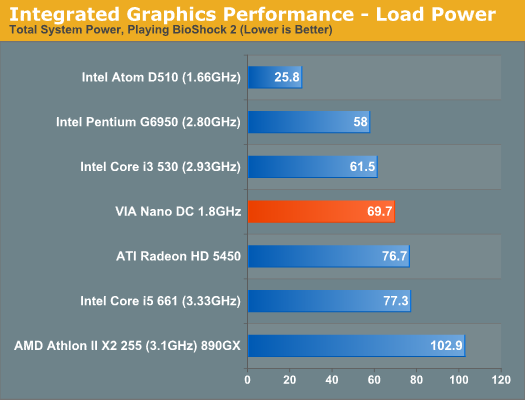VIA's Dual Core Nano & VN1000 Chipset Previewed
by Anand Lal Shimpi on November 15, 2010 12:26 PM ESTPower Consumption
The DC Nano platform I tested is built on an old 65nm manufacturing process at TSMC. As a result, power consumption isn't that great. Also note that VIA doesn't do any power gating, so idle power ends up being very similar to Clarkdale:


While the DC Nano platform may have the performance advantage, it requires at least twice the power of Intel's Pine Trail Atom platform. The move to 40nm will definitely help things, but I doubt we'll see Atom levels of power consumption from the final DC Nano platform.










54 Comments
View All Comments
LoneWolf15 - Tuesday, November 16, 2010 - link
I still have an MSI KT4-VL (KT400 chipset) on my workbench that was in my parent's system. For over five years without complaint it ran an Athlon XP-M (Barton) 2500+ clocked at 2.3GHz in their system, and it still runs fine.Graphics aside, VIA's chipsets have been solid over the years, as long as a reliable vendor built the mainboards. Trouble is, lots of VIA chipsets were bought by companies like ECS to build budget mainboards. The chipsets weren't the problem, but the manufacturing process and quality control gave the boards reputations, and VIA an undeserved black eye along with it. When someone like ASUS or MSI made a VIA board, it always turned out just fine.
Snotling - Tuesday, November 16, 2010 - link
The black eye was totally deserved, mostly for all the bad rep their faulty chipsets and buggy drivers caused to AMD in the K6 period.as far as I'm concerned, VIA had three relatively usable products, the KT266 Chipset (and its updated variants 333 and 400) beyond that They were totally Owned by NForce.
Also their sound chips (Envy) were decent and onboard graphics, when used on server boards did the job.
other than Than, its all under performing and unreliable CR@P
mczak - Monday, November 15, 2010 - link
Yes, and this being a 65nm sample is a problem - it means the final product may appear too late to be still relevant.The cpu looks ok so does the gpu - so as a faster (but more power hungry) alternative to atom this looks just fine. The problem is Bobcat does so too, and might (this is mostly guesswork for now) be quite comparable in cpu performance, a bit better in gpu performance, and still have possibly a bit lower power draw, while being released much earlier. So with this appearing quite a bit later that might not be very convincing. Heck it will probably have to deal with the new atom when it's finally released (cedarview) - which is rumored to have a better graphic core, though it seems likely the via platform would retain a performance advantage both for cpu and graphics (but the difference in power could grow even more, with difference in performance shrinking).
ClagMaster - Monday, November 15, 2010 - link
You do not know what you are talking about.I has a KT266A chipset Soyo K7V Dragon Plus that I was very satisfied with.
The KT266A chipset did what it was designed to do well. However, the caps on the motherboard were crap from the P50 electrolyte fiasco that victemized everyone. I hope the industrial spy responsable for this is rotting in a Taiwanese prison.
VIA was the principal chipset manufacturer that kept AMD Athlon CPU going until nVidia came along with nForce2 and stole their lunch.
This is a really promising product for low end office computers. Its not junk and should perform much better at 40nm.
However, I think AMD with Bobcat is going to steal their lunch.
Steelski - Tuesday, November 16, 2010 - link
I had a 400 series gigabyte motherboard. I thought grea, I might get something more out of my 1700+ chip If I get the nForce2 board....Boy was I wrong, I sold the Via and went blind with Nvidia, I had 4 nforce boards that were either unstable, unreliable, buggy or dead.
I should have stuck with the VIA, it was the best board I ever had!
silverblue - Wednesday, November 17, 2010 - link
Nah, the KT266A was excellent for its time, certainly better than the SiS735 and AMD761 chipsets that were around.SteelCity1981 - Monday, November 15, 2010 - link
What's interesting is that this cpu uses AMD-V Technology.DanNeely - Monday, November 15, 2010 - link
Look at the two closest to the IO ports. They appear to be PCIe 4x slots but installed backwards. Is this some oddity of a development/test board, or does Via intend to sell them like this. If so why?Goty - Monday, November 15, 2010 - link
This is more than likely just a development/prototyping board, so strange slot arrangements/alignments are normal.jackylman - Monday, November 15, 2010 - link
So if VIA can't compete with the big boys, it might be able to carve out a niche by doing something different, like actually working with the Linux/open-source community and/or working with S3 to make a damn good HTPC product .If they just want to live in the Windows world, they're not going to have much appeal.